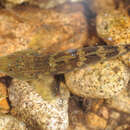Diagnostic Description
provided by Fishbase
This species is distinguished from its congeners by the following set of characters: D2 I,8; A I,8; pectoral-fin rays fin rays 36-40 (modally 19); longitudinal scale rows 32-35; transverse scale rows 9-10; predorsal scales 11-13 with a trifurcate anterior margin of which point 3 lies above the upper gill opening; vertebrae 10 + 16 = 26; gill opening extending ventrally to the vertical midline of the opercle. Coloration of males and females: males' basal region of body scale pockets with a bright orange spot, somewhat indistinct in females; the lateral side of females with a middle longitudinal row of discontinuous brownish black spots or bars and their dorsal lateral region with 3-4 longitudinal rows of black spots and the caudal fin base with 2 separate, vertical black bars; males with second dorsal fin with 4 longitudinal rows of reddish brown bars or spots and caudal fin with 8-10 waving vertical orange to brown stripes; pectoral fin base with a basal distinct, oblique deep brown stripe; cheek scattered with 16-25 small, orange red spots, brighter in males; the pectoral fin base of the species with a basal distinct, oblique deep brown stripe, followed by a parallel shorter, lighter stripe or waving mark (Ref. 104792).
Migration
provided by Fishbase
Amphidromous. Refers to fishes that regularly migrate between freshwater and the sea (in both directions), but not for the purpose of breeding, as in anadromous and catadromous species. Sub-division of diadromous. Migrations should be cyclical and predictable and cover more than 100 km.Characteristic elements in amphidromy are: reproduction in fresh water, passage to sea by newly hatched larvae, a period of feeding and growing at sea usually a few months long, return to fresh water of well-grown juveniles, a further period of feeding and growing in fresh water, followed by reproduction there (Ref. 82692).
- Recorder
- Cristina V. Garilao
Morphology
provided by Fishbase
Dorsal spines (total): 7; Dorsal soft rays (total): 8; Analspines: 1; Analsoft rays: 8; Vertebrae: 26
Trophic Strategy
provided by Fishbase
Inhabits lakes and rivers. Juveniles move into the sea and return to rivers after several months. This species has several types differentiated according to shape, coloration, and life history. Each type is isolated by habitat in the same stream (Ref. 559). Landlocked species and also have an amphidromous life history, spending portions of their lives in both fresh and marine waters (Ref. 58910).
- Recorder
- Grace Tolentino Pablico
Biology
provided by Fishbase
Adults inhabit lakes and rivers. Juveniles move into the sea and return to rivers after several months. This species has several types differentiated according to shape, coloration, and life history. Each type is isolated by habitat in the same stream.
- Recorder
- Cristina V. Garilao
Rhinogobius brunneus
provided by wikipedia EN
Rhinogobius brunneus, the Amur goby, is a species of fish in the family Oxudercidae. It is found in the Asian river basins of the seas of the Pacific coasts of Japan, Hokkaido, Ryukyu, Taiwan, the rivers of Korea, continental China, the Philippines and Viet Nam.[1]
Size
This species reaches a length of 58.0 cm (22.8 in).[2]
References
-
^ Masuda, H., K. Amaoka, C. Araga, T. Uyeno and T. Yoshino, 1984. The fishes of the Japanese Archipelago. Vol. 1. Tokai University Press, Tokyo, Japan. 437 p. (text).
-
^ Froese, Rainer; Pauly, Daniel (eds.) (2015). "Rhinogobius brunneus" in FishBase. February 2015 version.

- license
- cc-by-sa-3.0
- copyright
- Wikipedia authors and editors
Rhinogobius brunneus: Brief Summary
provided by wikipedia EN
Rhinogobius brunneus, the Amur goby, is a species of fish in the family Oxudercidae. It is found in the Asian river basins of the seas of the Pacific coasts of Japan, Hokkaido, Ryukyu, Taiwan, the rivers of Korea, continental China, the Philippines and Viet Nam.
- license
- cc-by-sa-3.0
- copyright
- Wikipedia authors and editors

